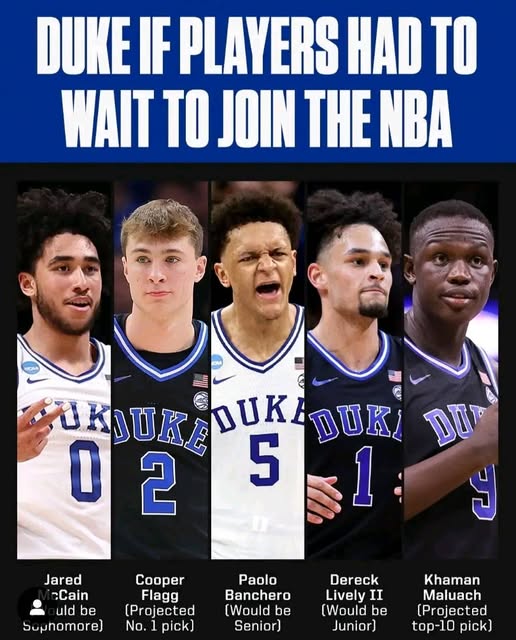In a bold, hypothetical twist to the current state of collegiate athletics, imagine a world where all college athletes—regardless of sport—are required to remain in school for a full four years before being eligible to enter any professional draft or sign with a pro team. This rule would upend the current system of early departures and “one-and-done” careers, reshaping college sports, professional leagues, and the lives of the athletes themselves. While such a policy might never be implemented in reality due to legal and labor challenges, its theoretical implications are worth exploring.
The Rationale Behind a Four-Year Mandate
The rationale behind instituting a mandatory four-year collegiate career could stem from multiple motivations. For one, it emphasizes the “student” in “student-athlete,” ensuring these young men and women have the opportunity to earn a degree before embarking on their professional journey. Additionally, proponents might argue that the maturity, physical development, and mental preparation fostered during a four-year collegiate experience could result in more polished athletes entering the professional ranks.
But beyond good intentions, the ripple effects of such a policy would be massive and complex.
Impact on Student-Athletes
Academic Advancement and Degree Completion
A clear benefit would be the drastically increased graduation rate among athletes. With four years in college, most players would earn a bachelor’s degree, equipping them with a fallback option in case their professional careers falter or never materialize. For many, especially those from underprivileged backgrounds, this educational requirement could serve as a powerful equalizer.
Health and Career Longevity
However, mandatory four-year participation in high-contact sports like football or basketball could also lead to increased injury risk. Top prospects currently depart early in part to minimize collegiate wear and tear while maximizing pro earnings. A mandatory stay could extend their time on the field without financial compensation equivalent to their market value, raising ethical questions—especially in sports prone to concussions or chronic injuries.
Delayed Earnings and NIL Considerations
Today’s athletes can cash in through Name, Image, and Likeness (NIL) deals, but the true financial windfall still lies in the professional leagues. Requiring four years in college delays access to multimillion-dollar contracts, endorsement deals, and other professional opportunities. While NIL could soften that blow, it’s unlikely to match the earning potential of leagues like the NBA, NFL, or MLB.
That said, NIL might take on an even greater role in this new world, as schools and sponsors compete to retain elite talent through escalating endorsement opportunities during their four-year stay.
Transforming College Programs
Team Continuity and Program Building
Under the four-year rule, college programs would enjoy unprecedented stability. No more worrying about top players leaving after one season—coaches could build true dynasties. Imagine a Kentucky basketball team with four years of Tyrese Maxey, or Alabama football with a senior Tua Tagovailoa. The result would be elevated team chemistry, strategic depth, and better overall gameplay.
Recruiting Overload and Roster Logjams
The flip side? With top players staying longer, roster spots would be scarce. Programs would have to be more selective, possibly offering fewer scholarships each year. Blue-chip high school athletes might find themselves waiting longer to play or transferring more often to find immediate roles. The transfer portal could become even more chaotic, as younger players jostle for time behind entrenched veterans.
Mid-Major and Non-Power Programs Rise
The rule could also level the playing field between Power Five programs and smaller schools. With elite talent distributed more evenly due to limited roster flexibility, mid-majors could gain national prominence. Programs like Gonzaga in basketball or Cincinnati in football could see more Final Four or Playoff appearances, creating a more balanced and unpredictable competitive landscape.
Effects on Professional Leagues
NBA: The Death of One-and-Done
Perhaps the biggest impact would be felt in the NBA. The one-and-done era—where stars like Zion Williamson, Anthony Davis, and Paolo Banchero spent only one season in college before leaping to the league—would be over. Instead, the NBA Draft would feature only players who have spent four full years in school, meaning older, more physically mature, and mentally prepared draftees.
The downside? Teams may miss the opportunity to mold younger players to fit their systems. There’s also the risk that injuries in college could diminish the potential of high-ceiling talents.
Still, scouting might become more reliable, as teams would have a larger body of work to evaluate. Fewer “busts” and more NBA-ready players could become the new norm.
NFL: A Minor Adjustment
The NFL already requires players to be three years removed from high school before going pro, so a four-year rule would be a relatively modest shift. Some redshirt sophomores or juniors who currently leave early would now stay an additional year. While it might benefit development, the added year could also risk injury for those already NFL-ready.
NIL deals could be essential for elite players who otherwise would leave early. Think of a senior Derrick Henry or Saquon Barkley staying at Alabama or Penn State with lucrative endorsements to match.
MLB, NHL, and Soccer: A Unique Challenge
Baseball, hockey, and soccer have different developmental paths. Baseball uses a mix of high school draft picks and minor leagues. Hockey leans heavily on international leagues and juniors. Soccer is increasingly bypassing college altogether.
For these sports, a universal four-year requirement could disrupt established pipelines. Baseball prospects, in particular, might chafe at having to delay minor league development. Soccer players may choose to go overseas rather than comply. The rule would likely need major exceptions or risk losing top-tier talent altogether.
Fan Engagement and Revenue Impacts
More Familiar Faces, Bigger Stars
One of the most exciting possibilities? Fan engagement would soar. Instead of seeing a future lottery pick for one year, fans could follow a player’s full college journey. Think of Caitlin Clark playing all four years (which she did) becoming the norm. Rivalries would deepen, narratives would build, and jersey sales would rise. Imagine four seasons of Angel Reese vs. Aliyah Boston, or Caleb Williams vs. Quinn Ewers.
Increased Ticket Sales and Viewership
Programs could build marketing campaigns around four-year stars, boosting TV ratings, ticket sales, and merchandise. The NCAA Tournament and College Football Playoff would see higher stakes and greater name recognition among players, enhancing the overall spectacle.
The Ethics and Legalities of a Four-Year Rule
While it’s intriguing to imagine, enforcing such a rule would likely face stiff opposition. Courts could view it as a violation of personal freedom and an illegal restriction on trade. Legal challenges would emerge under labor laws, and athletes’ unions at the pro level might fight it outright.
Moreover, such a policy could disproportionately affect athletes from low-income backgrounds who need to support their families. Delaying their professional careers could be seen as an unjust barrier to economic opportunity.
The only way a four-year rule could survive legal scrutiny is if it came with strong financial protections—NIL reform, health care, insurance coverage, and guaranteed scholarships for life.
The Evolution of Coaching
Strategic and Emotional Growth
For coaches, this rule would dramatically alter player development. Instead of rushing to teach NBA or NFL basics in one year, they could install complex systems over time. Player leadership would flourish, and mentorship would thrive. Veteran-laden teams could set cultural standards, while younger athletes would learn the value of patience and progression.
The Pressure of Retention
On the flip side, the four-year commitment might shift the pressure from recruiting to retention. With NIL becoming more pivotal, coaches would need to become better talent managers and relationship-builders, not just tacticians.



